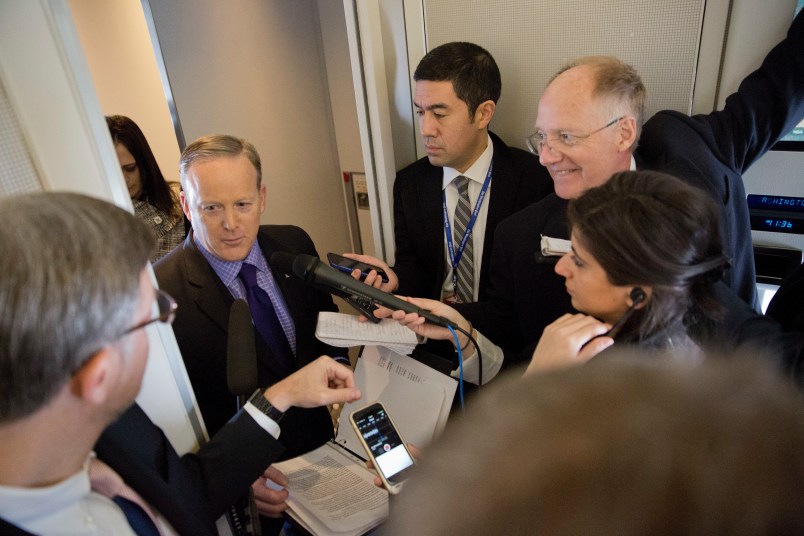White House Press Secretary Sean Spicer said Thursday that Donald Trump planned to pay for a border wall with Mexico by convincing Congress to impose a 20 percent border tax on imports from Mexico. Shortly afterwards, however, he told the White House press corps that the proposal was just one of multiple options to pay for the wall.
Speaking in a gaggle on Air Force One, Spicer said the administration’s plan to force Mexico to pay for the wall included “using comprehensive tax reform as a means to tax imports from countries that we have a trade deficit from, like Mexico,” according to a pool report.
“If you tax that $50 billion at 20 percent of imports–which is by the way a practice that 160 other countries do–right now our country’s policy is to tax exports and let imports flow freely in, which is ridiculous,” Spicer told reporters, according to the pool report. “By doing that we can do $10 billion a year and easily pay for the wall just through that mechanism alone. That’s really going to provide the funding.”
He said he had been in touch with congressional leadership about the plan, which he said “respected” American taxpayers.
“This is something that we’ve been in close contact with both houses in moving forward and creating a plan,” he said, as quoted in the pool report. “It clearly provides the funding and does so in a way that the American taxpayer is wholly respected.”
Asked about a border tax’s impact on Americans who buy goods from Mexican manufacturers, Spicer dodged.
“I’m not going to get into it,” he said, according to CNN.
Robert Reich, former labor secretary for President Bill Clinton, was speaking on MSNBC when he heard news of the proposal.
“It very easily could start a trade war, it’s stupid,” he said in reaction.
Very shortly after his initial statement to the press, according to multiple reporters, Spicer walked back his statement, saying the proposal was only one possible option:
BREAKING: Spicer tells me 20% tax on Mexican imports is NOT a policy proposal, but example of options how to pay for wall.
— Peter Alexander (@PeterAlexander) January 26, 2017
UPDATE: Sean Spicer seems to walk back border tax proposal, saying it’s only one option. “There are clearly a bunch of ways it can be done.”
— Gregory Korte (@gregorykorte) January 26, 2017
WH update from our @JDiamond1 ..Spicer says 20% import tax is just a possible option and that there will be no exec orders signed today
— Jim Acosta (@Acosta) January 26, 2017
This post has been updated.








And I will pay my mortgage with money I print myself…
And the tax will be paid by those patriotic Trump supporters. It will also finance tax cut for the rich.
That isn’t a tax on Mexico, that is a tax on US consumers. All that will happen is people will shun Mexican products, forcing the production to Asia. Meanwhile the economy in Mexico and the US border states will be hurt which could tip the US back into a recession. It is a steep price to pay for something we don’t need.
Yep, nothing like starting a trade war to improve trade deficits and kick-start the economy.
Isn’t that a tariff? Turnip is going to start a trade war.